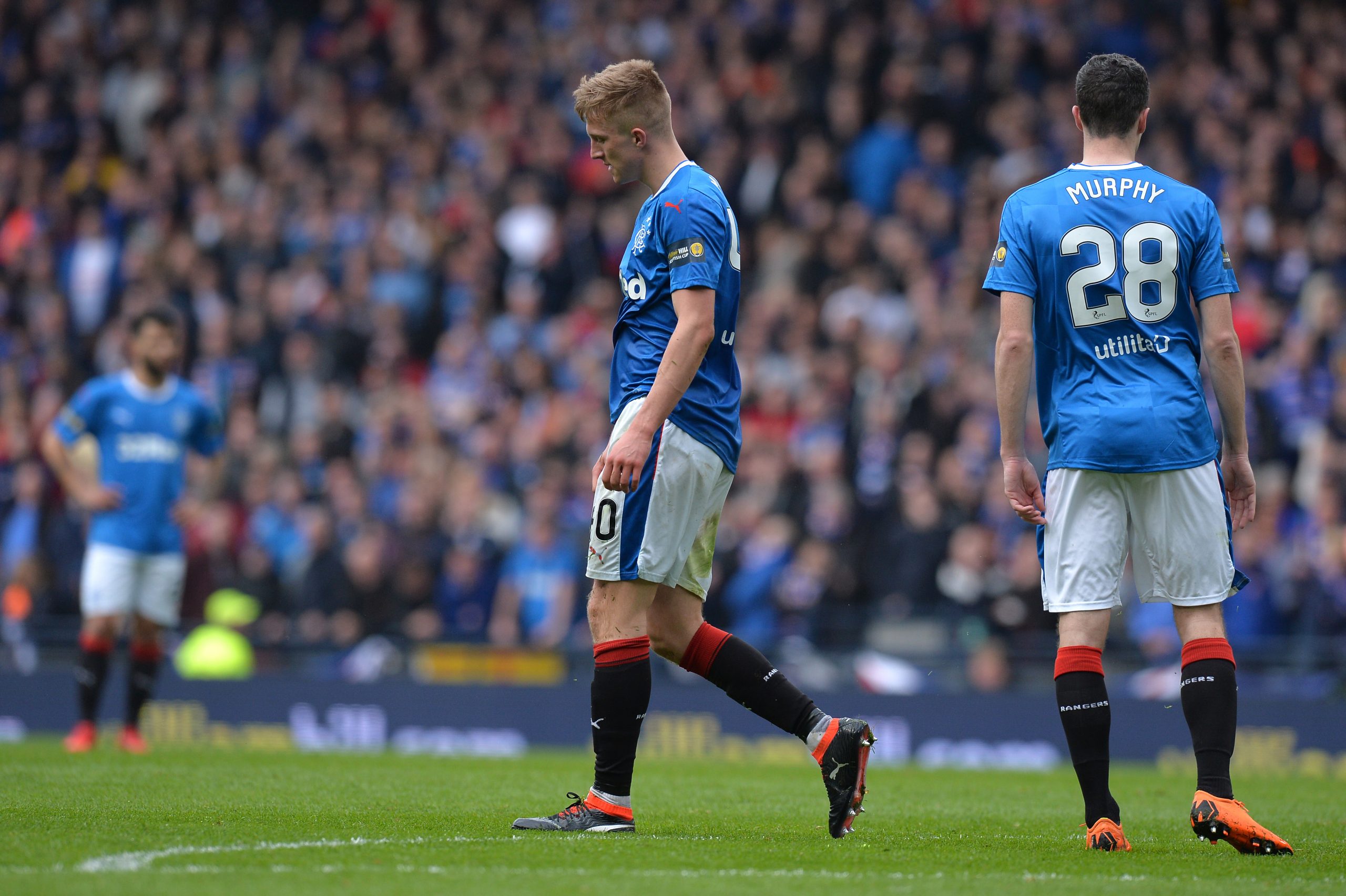From hamstring troubles, contracting the Coronavirus and even getting sent off on his debut, Ross McCrorie’s term as a Portsmouth player has been far from uneventful. A player who is rated as highly as any by his followers back home in Glasgow, it’s safe to say that Pompey, for all the quality that he has produced, didn’t see a level anywhere near his best.
Taking this into consideration, Kenny Jacket’s frustrations about the signing are understandable. Speaking to The News in December of 2019, the Portsmouth manager said, “He hasn’t been able to get there and that does happen for one reason or another. He just has to be patient, get back and when he is he can stay (in the side).”
The interesting thing to note from the above quote is that despite the midfielder’s struggles with injury, Jackett remained optimistic about his overall potential. Now, whether or not the youngster is going to be given a first-team opportunity by Gerrard next season remains to be seen. Still, one thing that can be said with certainty is that the weight of expectations is already taking its toll on the player.
The fact that he was so impressive when he first broke out at Rangers hadn’t done him a favour, as the expectation levels when he joined Portsmouth on loan – from Rangers and Pompey supporters alike, were sky-high. Having displayed precisely what he’s capable of in the first few months, it does look like the youngster is being held back by the sheer number of people that are waiting for him to kick on.
The midfielder made 17 appearances in the league during his first full season with the Gers’ first-team, while the second Premiership campaign at the Ibrox also yielded the same number. Although it wouldn’t be far-fetched to assume that a player who featured so many times for Rangers would be a regular at Portsmouth, he made the same 17 league appearances last time around as well, thereby highlighting an apparent lack of progress, owed mainly to the massive expectations.

How Did Ross McCrorie Make A Name For Himself At Rangers?
McCrorie is a direct product of the world-famous Rangers youth system, where given the great history of the football club, grandeur is embedded into the curriculum. He started his career as a central defender, and understandably, the Scot took next to no time in getting recognised by the former first-team coach, Pedro Caixinha.
Having impressed the staff thoroughly at a youth level, the Portuguese manager, whose success at the Ibrox was minimal, was full of praise for the youngster. He was given his debut in a Betfred Cup fixture against Partick Thistle back in 2017, and immediately after the game, the gaffer branded the defender to be a player with enough potential to be ‘one of the best centre-halves in history, not just for this club but for this country.’
Having initially been touted to be a central-defender, it didn’t come as a huge surprise when the youngster was gradually seen being eased into a multitude of positions. McCrorie’s skill-set is so well-rounded that the former defender was often utilised at central midfield by the Ibrox club, while more recently, Pompey had him operating out of the right-back role. Versatility hence was one of his mammoth selling points.
How Has McCrorie Performed In His Professional Career So Far?
As mentioned earlier, the Scot can play across a variety of positions, and this undoubtedly had a massive part to play in the amount of game time he received. After being given his debut as a 19-year-old in the 2017/18 campaign, the youngster went on to participate in a further 17 Premiership appearances – most of them in midfield, in what was his first full season with the first-team setup.

McCrorie further caught the attention of the Ibrox faithful after scoring his first goal for the side with a delicious header from a corner – a finish that English veteran Jermain Defoe would’ve been proud of himself. This highly successful campaign was followed by another year where he went on to make, just as before, 17 Premiership appearances. Although a large number of these were actually off the bench, it’s worth taking into consideration that the player was still extremely young and that the team in question were the historic Glasgow Rangers.
He went on to make his European debut during that campaign in the Europa League as well. Having endured what was seemingly the beginning of his full-fledged Rangers career after making 31 appearances under Steven Gerrard, the youngster was surprisingly shipped out on loan to Portsmouth at the start of the 19/20 league campaign. Possibly prompted to do so by his lack of high-profile footballing experience and the promise of regular playing time, it’s safe to say that his presence would’ve come as a boon to the Gers this term.
How Has McCrorie’s Stint At Portsmouth Gone?
The youngster didn’t enjoy the most significant first half to the season at Pompey but found himself with 22 appearances under his belt. The biggest challenge came in the form of a frustratingly unfortunate hamstring problem, which kept him out of the side for multiple spells all through the campaign. Although McCrorie didn’t manage to open his scoring for the English team, considering that he was being deployed at right-back makes his return of five assists look decent enough.

The most recent news that came out of the Gers camp regarding the player confirmed that he’d be staying on at Pompey through the playoff games. Jackett was once again quick to express his belief in the youngster as he said, “All of the loan players are good to play in the playoff games – and should we get through to the final they are okay as well. Ross has been extended until the end of the playoffs and he played 45 minutes against Reading the other day.”
McCrorie too has conceded that his time as a Portsmouth player was enjoyable. He said, “I’ve enjoyed my time here. There was one big injury and then perhaps I came back a bit too soon from that. But I love the city and all the lads. The fans and coaching staff all welcomed me and I feel I’ve given a good account of myself.”
With the playoffs now behind Pompey, the coming weeks and months are sure to reveal exactly what the future has in store for the youngster. The League One side failed in their bid to reach the EFL Championship, losing out to Oxford United on penalties after a tied scoreline at the end of the two legs. McCrorie featured from the start in the first-leg, but it was his lapse of concentration that led to one of the Oxford goals. He didn’t play any part in the second leg of the tie.
What Does Ross McCrorie Actually Add To The Team?
Strengths
Offensive Awareness
In the image below, the youngster is seen in a fairly attacking position, with the ball looping well over the heads of everyone involved in defending it. To McCrorie’ scredit, not only does he manage to get under the falling ball first, but he also had the calmness required to bring it under control and lookup for the next pass.


Having already beaten a couple of defenders, the Scot takes just seconds to weigh up his options before releasing the perfect pass to the middle of the box, where the Pompey attackers were lining up to slot the ball home. This highlights the ball control and awareness that the youngster would add to any team he plays for.
Versatility
One thing that has been established about the youngster is his general versatility, and ability to satisfactorily perform across a variety of roles and positions. He has been seen operating as a centre-back, a midfielder, and more recently, even a right back. Of the three, it’s safe to say that McCrorie is undoubtedly best-suited to playing as one of the anchors in a midfield two.
The biggest takeaway from the chart below has to be just how well-rounded McCrorie’s attributes are. Not only does the youngster possess all the primary skills required to be a successful defender, but he also has various other qualities that could be put to use in other areas of the pitch. The fact that his pace and passing stats are better than his numbers for marking highlight exactly why he was moved into a midfield slot.

While his ratings for marking and strength are right up there, the fact that he also displays strong stamina, tackling, aggression and work-rate, make him a good option to use in the middle of the park. It’s likely that his overall quality and technique on the ball were so advanced for a defender, that his coaches conjured up the idea that he might, in fact, be better suited to central midfield.
As shown by the player’s Football Manager 2020 profile, McCrorie boasts a right blend of statistics, with bravery and determination standing out from the rest. One thing that is clear from the above numbers is that the Scot’s general skill-set is far too balanced for him to be utilised exclusively as a central defender. In fact, if there was one other player from his generation who falls under the same category as McCrorie, it would have to be West Ham’s Declan Rice, who started his career as a centre-half but has successfully transitioned into a holding midfield role.
Short Passing In Attack
One of his standout skills is his ability to complete every short pass he takes on successfully. Despite being young, McCrorie shows extreme composure with the ball at his feet, and irrespective of whether the situation calls for a sly dribble or an easy pass, he tends to make the right call.
In the instance that has been highlighted below, McCrorie finds himself in a pretty advanced position in the opposition half but has been met by two defenders from the other side. His two realistic passing options had both been blocked off, and the most sensible move in such a situation would be to simply turn around and play the ball back.

Instead, McCrorie uses his awareness to drag the two defenders towards himself, in an attempt to keep up the intensity of the Pompey attack. As a back-pass would’ve eased the pressure, the Scot chose to move the ball sideways, thereby attracting tackles from either of the opposition defenders positioned in front of him.

The youngster’s movement with the ball at his feet not only dragged two defenders away but also created an additional avenue for his Pompey teammate to exploit.

Even with all the positive work that he’s done so far in the situation, none of it would matter if he couldn’t find the right pass. McCrorie though used his intelligence to carve the ball right through the space in between the two defenders to pick out a teammate and keep the attack flowing.
Offensive Decision Making
The youngster rarely makes the wrong decision in the attacking phase, as can be seen from all the assists he picked up for Pompey last season. Mature enough to understand when he should take on a defender and when he should look for a pass, the Rangers man tends to maintain a calm and composed head in even the most high-pressure attacking situation.

In the picture shown above, McCrorie is released down the right flank as Pompey had been beginning to pile on the pressure on the Shrewsbury back-line. In this situation, the youngster does have the option of looking up and picking out the first-time ball.

Instead, the versatile midfielder understands that there is a space next to one of the defenders that he can exploit. One-touch to move the ball away from the defender’s reach and another to cross it was all it took for the home side to break the deadlock, thanks to the brilliance of McCrorie.
Tackling
Having started his career as a central defender, tackling is undoubtedly one of the Rangers man’s strengths while tracking back. He offers good physical presence when operating in the middle of the park while displaying a strong work-rate when playing in the right-back role. Although his positioning isn’t necessarily the greatest, the youngster makes up for it to a certain extent, thanks to his superior tackling skills.

In the image displayed above, McCrorie can be seen preparing to approach one of the Oxford United attackers from behind. In today’s footballing world, most forwards will go down to even the slightest of touches, and when that touch comes from behind, they often tend to be given as well.

The easiest thing to do in such an instance would be to drop off and allow the midfielders to deal with the situation at hand. Instead, McCrorie, full of confidence in his tackling abilities, steps up to the player in question, albeit without getting too close. The Oxford attacker, upon receiving the ball, isn’t left with too many options to choose from and is hence forced to try and turn. The Scot uses this opportunity to nick the ball from in between the feet of the attacker.
Weaknesses
Defensive Positioning
For all the positives that McCrorie does bring to the table, one thing that must be conceded is that his defensive positioning is nothing short of appalling. Although many would likely try and put that down to his natural position, the fact remains that positioning is just as important when operating in the core of the side. He tends to lack awareness about where the opposition attackers are, which thereby leads his positioning to go haywire.
In the situation below, McCrorie has been deployed as the right-back by Kenny Jackett, in a fixture against MK Dons in the league. After a flurry of chances at the other end of the pitch, the Dons initiated a quick counter-attack, which caught most of the Pompey squad out of position. Thankfully for McCrorie, he hadn’t wandered too far away from his post.

When faced up by a speedy winger in a counter charge, the most effective way to deal with the situation is by sending the attacker as wide as possible, while also buying enough time for teammates to arrive and provide cover. The direction that he should’ve been jockeying in is highlighted above, but the Scot decided to try something else.

The move that McCrorie went on to make cost Pompey their only goal of the night, and in the process denied what should’ve been a comfortable clean-sheet. Instead of either buying time by holding, or sending the attacker wide with better positioning, the youngster decided that the best thing to do would be to challenge for the ball. This allowed the pacy Dons attacker the time and space required to cut inside, thereby taking the right-back out of the equation.

By the time the forward cuts back outside once again, McCrorie is completely disoriented in terms of his positioning, and instead of taking a step back and potentially analysing the situation, he ends up bringing the Dons man down, giving away a needless penalty in the process.
Another instance of the youngster’s poor defensive positioning highlights his general lack of concentration while deployed as a member of the back-line. In the image shown below, the Scot can be seen looking on as the Pompey centre-half drags the opposition attacker to a corner. McCrorie should have been alerted to the fact that an Oxford player is standing behind him as well.

Instead of trying to cover the free man behind him, the Scot instead chooses to ball-watch, in an instance that could’ve yielded bad results for the Pompey back-line. Unaware of the open player behind him, McCrorie continues to try and progress towards the ball, thereby opening up space for the Oxford attacker to exploit. A simple look at what’s behind would’ve completely eliminated this situation.

The spare man who was free behind McCrorie was allowed the time and space required to exploit his poor positioning, and if it wasn’t for timely cover from the other Pompey centre-half, this attack could’ve easily led to an Oxford equaliser.

Another instance where McCrorie’s poor defensive positioning is highlighted is given above. In this situation, the Oxford full-back finds himself in an advanced position, with enough time and space to pick out a quality forward pass. He chooses to play the ball down the flank, in the hope that the winger can pick it up.

When the ball is released, the first thing worth noticing is that McCrorie isn’t anywhere near where he actually should be. After that though, instead of trying to adapt to the situation at hand and put a stop to the Oxford attacker’s progress, McCrorie’s first instinct is to get back into position.

The Rangers loanee’s decision to try and get back into position rather than adapt to the predicament allows the Oxford attacker even more time to make a decision. The ideal move for the Scot to make would’ve been to simply force the forward wide with the help of his advanced centre-half teammate. Instead, McCrorie chose to send the centre-half back, and simply slotted into the full-back role again. This allowed the attacker the space he needed to get free towards the inside channel.
Defensive Awareness
Although Scot is known for his ability to pick up the ball in midfield and beat a couple of challenges using only his sheer awareness, he doesn’t quite boast the same level of instincts when it comes to the defensive phase of things. In the image shown below, McCrorie can be seen tracking back in the wide area, with two opposition attackers charging him down from either side.

Even though Oxford have a two against one advantage in the situation, McCrorie’s proximity to the ball, added to the time he has to make a decision, should make this a simple task for a “seasoned” defender. Unfortunately, McCrorie is unaware of the man behind him and thinks that all of the pressure is coming from the right side. To this effect, the youngster turns the ball and blocks off the challenge from the first Oxford attacker.

Having turned around with the assumption that he’s got himself out of a sticky situation, the Scot sees another Oxford player charging at him. Confused between the options, McCrorie tries to trick his way out of the tight spot, but instead loses his balance and falls over. This gives the approaching Oxford attacker a free run with the ball, with space left open in front of him by a fallen full-back as well.

Lack Of Intensity
The image shown below highlights another instance where Pompey were put on the ropes by an Accrington Stanley counter-attack. McCrorie, wearing 15, was deployed as the central defensive-midfielder for this tie, and was directly responsible for providing cover to the back-line.

It took Accrington over ten seconds to get the ball from defence to attack, and once they did, there were a couple of passes involved before the striker got into this position. The worrying thing about this frame is the fact that the defensive-midfielder – the man responsible for adding mettle to the back-line, is seen jogging back with no desire whatsoever to try and get behind the ball.
The image below highlights another situation where the full-back has displayed an alarming lack of intensity while tracking back. Although this could be put down to the fact that he isn’t a natural defender, the fact that McCrorie had been deployed in the role all season actually throws light on the situation.

When the Oxford full-back picks the ball up near the halfway line, with only one Pompey player in opposition territory, which means that their previous attack hadn’t really picked up pace before the ball was turned over. In such a situation, the first players that will be asked to get back to position are the full-backs, who can be caught out while going in either direction.

In the above image though, McCrorie can be seen casually jogging back, while the Pompey centre-half is having to cover for him down the flank. Not only that, while the rest of the defensive line has regained its shape, the Scot seems to be displaying a lack of enthusiasm to get back into position. Although a defensive lapse of this sort probably wouldn’t have the greatest of an impact if he were playing in midfield, as a full-back, this single instance could’ve cost Pompey a goal in this move.
Doesn’t Have A Primary Position
As positive and desirable as versatility can be, one concern that’s bound to arise for any manager coaching such a player is finding their actual best position. McCrorie though seems to be at his absolute happiest when operating in midfield with the freedom to chase the ball down and make early attacking runs. Playing in multiple positions can cause problems if the player isn’t used to it, mainly because footballers tend to use their first instincts quite a lot while on the pitch. The first instincts of a midfielder and a defender will never be the same. This is exactly what is highlighted in the instance shown below.

McCrorie finds himself in an advanced position in the Oxford box, where he sees an opportunity to win the ball and potentially release one of the attackers. A regular full-back, in such a situation, would’ve probably left the ball to the midfielder, to try and offer the man in possession a good passing option down the flank. Instead, being a midfielder by trade, McCrorie’s first instinct is to try and win the ball back.

The youngster ends up getting the ball stuck between his feet, and loses it to an Oxford midfielder. The attack that the away side launched from this situation is the one that led to the equaliser. Had a natural full-back been playing there instead of McCrorie, the end result of this instance might well have been very different.

By being used at right-back, the youngster is being made to play in a role where he’s having to make adjustments to perform at the same level. This has the potential to alter the player’s overall skill-set, and ultimately change his attributes in the process. This further means that using McCrorie in so many different positions could have a direct impact on his effectiveness in the core of the team.
What Is Rangers’ Current Midfield Situation?
If there was one piece of positivity for the midfielder to derive from the Rangers’ current midfield predicament, then it would have to be Steven Gerrard’s apparent lack of clarity regarding his first-choice midfield trio. The likes of Scott Arfield, Joe Aribo, Glen Kamara and Steven Davis have all been utilised in spells, but at no point last season had there been a set midfield. The only mainstay in the Gers’ first-team setup was Ryan Jack.

McCrorie, who did a decent-ish job at Pompey, should come into the side next season looking to exploit just that. Steven Davis is edging towards the final years of his career, while Scott Arfield isn’t getting any younger either. The former Premier League stars have both slowed down considerably too, meaning that their spaces being up for grabs is nothing but a matter of time.
With that said though, it’s worth considering that the only player that McCrorie can readily replace in the team is Ryan Jack, as he’s the one who is often utilised in the central defensive midfield role. As good as last season’s Pompey loanee is on the ball, playing him in a more advanced position would limit their attacking creativity, thereby slowing things down while going forward.
Adding McCrorie to the mix would offer Gerrard a few more options as to how they might be able to set up. Although the Scot is undoubtedly at his most comfortable when playing alongside another midfielder, it wouldn’t be too far-fetched for him to work on playing as the lone anchor. What this means is that McCrorie can be used as a back-up option to Jack next season, with the former coming into the side whenever the latter needs a break from the action.

McCrorie’s passing and dribbling skills are right up there, and if he’s able to nurture his defensive positioning as well, then there’s no reason the youngster couldn’t break into Gerrard’s first team as early as next season. Taking over from Jack will be a gradual process though, and anyone who thinks that the youngster is ready to do so is almost certainly in the wrong.
What Is Ross McCrorie’s Best Position?
The midfielder was initially brought up through the Rangers system as an out-and-out centre-half, but it wasn’t long until the coaches seemingly realised that McCrorie has the quality to operate in midfield. The youngster’s tackling, heading and sheer work-rate are what prompted the Gers to promote him to the first-team, but after seeing his on-the-ball ability as well as composure in possession, they were quick to move him into the core of the side.
With that said though, it has already been established above that the biggest weakness in Ross McCrorie’s game is his terrible defensive positioning. A holding midfielder is never going to be devoid of defensive duties, which means that playing him as the lone anchor could have dire effects.

With all this in mind, it can be discerned that the Scot will be at his most effective when operating as the part of a midfield duo. This would allow the youngster the time and space he needs to conduct the play from the middle of the park, while his partner could relieve him of some of the defensive duties. The way to get the best out of McCrorie is undoubtedly by redirecting a lot of the defensive burdens off his head, thereby streamlining his full concentration towards dictating moves.
Given that Gerrard is unlikely to alter his formation just to suit the preferences of a single player, McCrorie will need to work on his defensive attributes before he can challenge Ryan Jack for the midfield anchor role. The youngster boasts amazing forward passing abilities, which means that he is already capable of doing a majority of the work that Jack puts in. One full season with the Gers first-team should now be enough to instil all the team values into him, and the upcoming Premiership campaign has all the makings of a breakthrough one.
What Seems To Be Driving McCrorie On At Rangers?
The 22-year-old spent the last season away on loan, after two rather successful years playing in the first-team for his boyhood club. Although staying on at the Ibrox would probably mean a limited amount of playing time, it’s evident that the youngster’s desire is to make a place for himself in the Rangers first-team eventually.
Speaking about an incident when he was a child, McCrorie said, “When I was playing under-12s football I broke my hand during a game against Celtic. I was so young at the time and had never experienced a bad injury. The coach at the time, Alan Kernaghan, took me to the side and basically told me – although not in so many words – that I had a few more weeks to decide whether I would get another contract.”

McCrorie then went on to explain where his determination to succeed at the Glasgow club arose from. He continued, “I told my mum that I didn’t want to do it any more and I’d rather be back playing with my pals – but she convinced me to stick at it and I’ll always be thankful for that pep talk. I got my contract and in the following season I had a mindset of ‘go out, do the best I can, and not hold back’. That’s when I kicked on through the youth ranks.”
Does McCrorie Have What It Takes To Make It At Rangers?
The case of Ryan Jack is one that should fill the youngster with a lot of confidence about his Rangers career. The Ibrox club acquired Jack from Aberdeen in the summer of 2017 on a free transfer. After a spell of decent campaigns for the men in red, it came as a surprise when one of the biggest clubs in the country chose to snap him up. Three years down the line and Jack is one of the most important pieces of Gerrard’s puzzle, and a similar fate would do McCrorie a ton of good.
Having already spent a majority of his career so far at the Ibrox, there’s no need even to question his big-club mentality. Although his showings at Pompey have earned mixed reviews, it’s worth considering that McCrorie is still only 22. As much as some of the fans would like to see the Portsmouth loanee back in the Gers’ first-team scenario next season, it would probably be in the player’s best interest to remain patient and not force the gaffer into making any unnecessary decisions about the prodigious player’s future at this time.
Editorial Note: Did you know this article appeared first on our Patreon page? We need you the viewers to help save The 4th Official! Due to the unprecedented situation as a result of the COVID 19 pandemic, the digital media space has been completely devastated. There has been a massive shortfall in revenue (even while viewership is up) as we scramble how to make sure that we go on with our daily job. We are proud to put up exclusive stuff on our Patreon account and hope you would support us in these tough times. Click the button below and please have a look as to how you can support us.


 ADD AS PREFERRED SOURCE ON GOOGLE
ADD AS PREFERRED SOURCE ON GOOGLE


